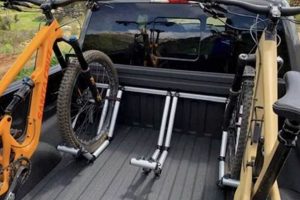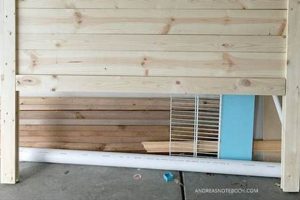Structures affixed to the sides of a truck bed, designed to provide anchor points, enhance cargo security, or offer aesthetic modifications, can be constructed by vehicle owners. These fabricated components typically utilize materials such as steel, aluminum, or wood, and are intended to increase the utility of the truck bed area. As an example, a set of self-made side barriers can prevent items from shifting during transport or provide a mounting surface for accessories.
The implementation of these self-assembled truck bed enhancements presents several advantages. They can offer a cost-effective alternative to commercially available options, allowing for customization tailored to specific needs. Furthermore, the ability to design and fabricate these elements facilitates a deeper understanding of vehicle mechanics and fosters problem-solving skills. Historically, truck owners have modified their vehicles to better suit work demands, reflecting a tradition of adapting equipment to practical requirements.
Subsequent sections will detail the considerations involved in material selection, design principles relevant to structural integrity, and the tools and techniques necessary for successful construction. Safety protocols and regulatory aspects relating to vehicle modifications will also be addressed.
Essential Considerations for Fabricating Truck Bed Side Rails
The following guidelines provide critical insights for individuals undertaking the construction of truck bed side rails. Adherence to these recommendations promotes safety, structural integrity, and regulatory compliance.
Tip 1: Material Selection: Evaluate material properties based on intended load capacity and environmental exposure. Steel offers strength, while aluminum provides a lightweight, corrosion-resistant alternative. Wood, while aesthetically pleasing, requires appropriate treatment to prevent degradation.
Tip 2: Design Validation: Employ structural analysis software or consult with a qualified engineer to ensure the design withstands anticipated stresses. Consider factors such as bending moments, shear forces, and weld integrity.
Tip 3: Welding Proficiency: If welding is employed, ensure competence in the selected welding process (e.g., MIG, TIG). Improper welds compromise structural strength and can lead to failure under load. Consult professional welders for complex or critical joints.
Tip 4: Secure Mounting: Attachment methods must be robust and reliable. Through-bolting with appropriately sized hardware is generally preferred over self-tapping screws. Distribute load across multiple mounting points to prevent stress concentration.
Tip 5: Corrosion Protection: Apply appropriate coatings or treatments to prevent corrosion, particularly in regions with harsh weather conditions. Powder coating, galvanizing, or the application of specialized primers and paints can extend the lifespan of the fabricated components.
Tip 6: Regulatory Compliance: Be aware of local and national regulations pertaining to vehicle modifications. Ensure that the fabricated side rails do not obstruct visibility, interfere with safety equipment, or violate dimensional restrictions.
Tip 7: Thorough Inspection: Prior to use, conduct a meticulous inspection of all welds, fasteners, and structural elements. Address any detected defects or weaknesses before subjecting the side rails to load.
Implementing these guidelines ensures a structurally sound and safe installation, contributing to the longevity and reliability of the constructed truck bed side rails.
The subsequent sections will delve into advanced techniques and troubleshooting strategies for optimizing the construction process.
1. Material Strength
Material strength is a foundational determinant of the performance and longevity of self-constructed truck bed side rails. The selection of a material with insufficient tensile strength, yield strength, or fatigue resistance directly compromises the structural integrity of the assembled system. The effect of using an inadequate material manifests as premature failure, either through bending, cracking, or complete separation under applied loads. For example, substituting mild steel with thin-walled aluminum in a high-stress application will likely result in deformation or fracture of the rails when subjected to heavy cargo or aggressive driving conditions. The importance of appropriate material strength lies in ensuring the safety of transported goods, the vehicle itself, and surrounding traffic.
The determination of appropriate material strength necessitates a comprehensive assessment of anticipated loading conditions. This includes static loads from cargo weight, dynamic loads from acceleration and braking, and environmental factors such as corrosion and temperature fluctuations. Steel alloys, such as high-strength low-alloy (HSLA) steel, offer increased yield strength and tensile strength compared to mild steel, making them suitable for demanding applications. Similarly, certain grades of aluminum, when properly heat-treated, can provide a favorable strength-to-weight ratio. Practical applications involve selecting thicker gauges of material or incorporating reinforcing structures, such as gussets or bracing, to compensate for inherent material limitations. Finite element analysis (FEA) software can simulate stress distributions and identify areas of potential weakness in the design, allowing for informed decisions regarding material selection and reinforcement strategies.
In summary, the correlation between material strength and the robustness of truck bed side rails is irrefutable. Selecting materials with adequate mechanical properties, informed by a thorough understanding of expected loads and environmental conditions, is paramount. Neglecting this critical aspect can lead to structural failure, compromising safety and necessitating costly repairs. Future advancements in material science and composite materials may offer further opportunities for optimizing the strength-to-weight ratio of self-constructed truck bed components.
2. Welding Proficiency
Welding proficiency constitutes a critical competency for individuals undertaking the construction of truck bed side rails. The integrity of the welded joints directly dictates the overall structural strength and safety of the fabricated assembly. Inadequate welding techniques compromise the load-bearing capacity and increase the risk of failure under stress.
- Weld Penetration and Fusion
Adequate weld penetration ensures the fusion of the base metals, creating a bond that effectively transfers stress. Insufficient penetration results in a surface-level weld susceptible to cracking and separation. For instance, a butt weld joining two steel plates must exhibit complete penetration to withstand tensile forces encountered during cargo transport. Visual inspection and destructive testing are methods to verify weld penetration.
- Weld Bead Profile and Consistency
The weld bead profile should be uniform and free of discontinuities, such as porosity, undercut, or slag inclusions. These imperfections weaken the weld and create stress concentration points. Consistent bead size and shape indicate proper welding parameters and technique. X-ray radiography can detect subsurface defects that are not visually apparent.
- Material Compatibility and Filler Metal Selection
Proper filler metal selection is crucial for achieving optimal weld properties. The filler metal must be chemically compatible with the base metals to prevent dissimilar metal corrosion or embrittlement. For example, welding aluminum requires the use of aluminum-specific filler alloys, whereas welding different grades of steel may necessitate specific low-hydrogen electrodes to mitigate hydrogen-induced cracking.
- Welding Process and Technique
The choice of welding process, such as MIG (GMAW), TIG (GTAW), or stick (SMAW), impacts the weld quality and efficiency. Each process has its advantages and limitations. For example, TIG welding offers precise control and high-quality welds suitable for critical joints, while MIG welding is more efficient for long welds. The correct technique, including travel speed, amperage, and voltage settings, must be employed to achieve optimal results. Formal welding training and certification programs provide instruction on proper techniques.
The application of sound welding practices significantly impacts the safety and durability of self-fabricated truck bed side rails. Individuals lacking sufficient welding skills are advised to seek professional assistance to ensure structural integrity and prevent potential hazards. The long-term performance and reliability of the truck bed side rails hinge on the quality of the welded joints.
3. Mounting security
The structural integrity of self-constructed truck bed side rails hinges critically on the method of attachment to the vehicle frame or bed. Inadequate mounting practices directly translate to a compromised system, increasing the risk of detachment, cargo loss, and potential vehicular accidents. The cause-and-effect relationship is straightforward: insufficient mounting security leads to structural failure under stress, whereas robust mounting ensures stability and load-bearing capacity. The importance of this aspect cannot be overstated, as it is a primary determinant of the overall functionality and safety of the fabricated component.
Real-life examples underscore the potential consequences of neglecting mounting security. Side rails attached with self-tapping screws alone, without reinforcement, are prone to shear failure under heavy loads or during dynamic driving conditions. Conversely, through-bolting with appropriately sized hardware, combined with backing plates to distribute load, provides a more secure and reliable connection. Consider the scenario of a truck transporting heavy equipment on rough terrain. If the side rails are inadequately mounted, the repeated stresses can cause the fasteners to loosen or break, leading to the rails detaching and potentially causing a hazard to other vehicles. The practical significance lies in understanding that the mounting system must be designed to withstand the anticipated forces and stresses generated during regular use.
In summary, mounting security represents a non-negotiable element in the self-construction of truck bed side rails. Proper mounting methods, including through-bolting, backing plates, and appropriate hardware selection, are essential for ensuring structural integrity and preventing catastrophic failure. Challenges often arise from insufficient planning, inadequate hardware selection, or improper installation techniques. Overcoming these challenges requires a detailed understanding of structural mechanics, careful attention to detail, and adherence to established engineering principles. The security of the mounting system directly correlates to the safety and effectiveness of the modification.
4. Corrosion resistance
The capacity to withstand deterioration induced by environmental factors is a critical factor in the design and construction of truck bed side rails. Without adequate corrosion resistance, these components are susceptible to degradation, compromising structural integrity and reducing their effective lifespan. The selection of materials, application of protective coatings, and design considerations all contribute to mitigating the effects of corrosion.
- Material Selection
The choice of base material significantly influences corrosion resistance. Steel, while offering strength, is prone to oxidation in the presence of moisture and electrolytes. Aluminum alloys, conversely, form a passive oxide layer that provides inherent protection against corrosion. Stainless steel offers superior corrosion resistance but may be cost-prohibitive for certain applications. Material selection decisions must balance corrosion resistance with strength requirements and budgetary constraints. For instance, in coastal environments, aluminum or stainless steel may be preferred over unprotected steel, despite the higher initial cost.
- Protective Coatings
The application of protective coatings serves as a barrier between the base metal and the corrosive environment. Galvanizing, powder coating, and specialized paints are common methods employed to enhance corrosion resistance. Galvanizing involves coating steel with a layer of zinc, which corrodes preferentially, protecting the underlying steel. Powder coating provides a durable, aesthetically pleasing finish that also acts as a corrosion barrier. The choice of coating depends on the severity of the environment and the desired aesthetic. For example, powder coating is suitable for moderately corrosive environments, while galvanizing is more appropriate for severe conditions, such as exposure to road salt.
- Design Considerations
Design features can either mitigate or exacerbate corrosion. Features that trap moisture or create crevices promote localized corrosion. Sharp edges are more susceptible to corrosion than rounded surfaces. Drainage holes allow water to escape, preventing accumulation and reducing the risk of corrosion. Proper design minimizes the potential for corrosion by eliminating or mitigating these factors. As an illustration, welding overlapping steel plates creates crevices that are prone to crevice corrosion. Incorporating a sealant or designing the joint to be fully welded can prevent this.
- Maintenance and Inspection
Regular inspection and maintenance are essential for preserving corrosion resistance. Identifying and addressing areas of corrosion early can prevent further degradation. Periodic cleaning removes dirt and debris that can promote corrosion. The application of touch-up coatings repairs damaged areas and maintains the integrity of the protective layer. Consistent maintenance extends the lifespan of the side rails and ensures continued structural integrity. For example, annual inspection of welds and coatings allows owners to proactively address rust spots or coating imperfections, preventing more extensive corrosion.
Integrating corrosion resistance into the design and construction of truck bed side rails is vital for their long-term performance and safety. Material selection, protective coatings, design considerations, and ongoing maintenance each play a role in mitigating the effects of corrosion. Neglecting this aspect results in premature failure, requiring costly repairs or replacements. Investing in corrosion resistance safeguards the integrity and lifespan of the fabricated components.
5. Design validation
In the context of self-constructed truck bed side rails, design validation constitutes a critical process to ensure the structural integrity and safety of the fabricated components. This validation process involves the systematic evaluation of the design to confirm that it meets specified requirements and performance criteria, thereby mitigating the risk of failure under anticipated loading conditions. Design validation is not merely an optional step, but an essential safeguard against potential hazards associated with structural deficiencies.
- Finite Element Analysis (FEA)
FEA is a computational method used to simulate the behavior of a structure under various loads and constraints. In the context of self-made truck bed side rails, FEA allows for the virtual testing of the design to identify areas of high stress concentration or potential failure. For example, an FEA simulation can predict the deformation and stress distribution in the side rails when subjected to the weight of a heavy load, such as construction materials. By identifying weak points in the design, engineers can optimize the geometry and material selection to improve structural performance.
- Load Testing
Load testing involves subjecting the fabricated side rails to controlled loads to verify their load-bearing capacity. This can be achieved through static load testing, where a constant load is applied, or dynamic load testing, where the side rails are subjected to repeated loads to simulate real-world conditions. As an example, a load test might involve placing sandbags or other heavy objects on the side rails to simulate the weight of cargo and measuring the resulting deflection. If the side rails exhibit excessive deflection or fail to support the applied load, the design must be revised.
- Material Verification
Material verification involves confirming that the materials used in the construction of the side rails meet specified standards and requirements. This includes verifying the tensile strength, yield strength, and other mechanical properties of the materials. As an example, a material certificate from the supplier can be used to verify that the steel used in the construction of the side rails meets the requirements of a specific ASTM standard. Material verification ensures that the design assumptions regarding material properties are accurate, reducing the risk of structural failure due to material defects.
- Peer Review
Peer review involves having the design reviewed by an independent engineer or experienced fabricator. This review can identify potential design flaws or areas for improvement that may have been overlooked by the original designer. For instance, a peer reviewer might identify a potential stress concentration point in a welded joint or suggest a more efficient method of attachment to the truck bed. Peer review provides an additional layer of validation and helps to ensure that the design is sound and safe.
These facets of design validation collectively contribute to ensuring that the self-fabricated truck bed side rails meet the required performance criteria and provide a safe and reliable solution for cargo transport. Ignoring design validation can lead to structural failure, posing a risk to both the cargo and the vehicle. Implementing a comprehensive validation process mitigates this risk and contributes to the longevity and safety of the fabricated components.
Frequently Asked Questions Regarding Self-Fabricated Truck Bed Side Rails
The following addresses prevalent inquiries concerning the construction and implementation of user-created truck bed side rails. These questions and answers provide clarification on design considerations, regulatory aspects, and safety protocols.
Question 1: What are the primary safety considerations when designing and constructing truck bed side rails?
Structural integrity is paramount. The side rails must withstand anticipated loads without deformation or failure. Welding should be performed by qualified individuals, and mounting must be secure to prevent detachment. Adherence to all applicable regulations is mandatory.
Question 2: Which materials are most suitable for constructing truck bed side rails, and what are their respective advantages and disadvantages?
Steel offers high strength and weldability but is susceptible to corrosion. Aluminum is lightweight and corrosion-resistant but may require specialized welding techniques. Wood provides aesthetic appeal but lacks the strength and durability of metal alternatives.
Question 3: How does one determine the appropriate dimensions and load-bearing capacity for self-made truck bed side rails?
Dimensions should be tailored to the specific truck bed and intended cargo. Load-bearing capacity must be calculated based on the anticipated weight of the transported items, with a safety factor incorporated to account for dynamic forces.
Question 4: What regulatory requirements must be considered when modifying a truck with self-constructed side rails?
Local and national regulations regarding vehicle modifications vary. It is imperative to consult with relevant authorities to ensure compliance with dimensional restrictions, visibility requirements, and safety standards.
Question 5: What are the recommended methods for protecting self-fabricated truck bed side rails from corrosion?
Protective coatings such as galvanizing, powder coating, or specialized paints provide a barrier against corrosion. Regular inspection and maintenance, including cleaning and touch-up applications, are essential for prolonging the lifespan of the side rails.
Question 6: How does one ensure the long-term structural integrity of self-constructed truck bed side rails?
Proper design, material selection, welding techniques, mounting methods, and corrosion protection measures are crucial. Regular inspections should be conducted to identify and address any signs of wear, damage, or corrosion.
In conclusion, the successful construction of user-fabricated truck bed side rails necessitates careful planning, adherence to safety protocols, and compliance with regulatory requirements. Neglecting any of these aspects can compromise the structural integrity and safety of the vehicle.
The subsequent section will provide a detailed guide on assembling the fabricated components.
DIY Truck Bed Rails
This exposition has detailed the multifaceted considerations inherent in the construction of user-fabricated truck bed side rails. Emphasis has been placed on material selection, design validation, welding proficiency, mounting security, and corrosion resistance as critical determinants of structural integrity and regulatory compliance. Failure to adequately address these elements introduces significant risk.
The fabrication of truck bed side rails demands a rigorous adherence to engineering principles and safety protocols. The information provided serves as a foundation for informed decision-making. Prudent application of this knowledge will contribute to the successful and safe implementation of truck bed modifications. Continued vigilance and adherence to best practices are essential to ensure the long-term reliability of these structures.







